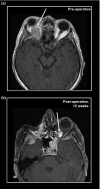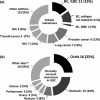High frequency of lobular breast cancer in distant metastases to the orbit
- PMID: 25355547
- PMCID: PMC4312124
- DOI: 10.1002/cam4.331
High frequency of lobular breast cancer in distant metastases to the orbit
Abstract
Metastasis to the periocular soft tissue of the orbit is a rare manifestation of metastatic cancer. Infiltrating lobular breast cancer (ILBC) is a special breast cancer subtype, which accounts for 10-15% of all mammary carcinomas and for ~1% of all malignancies. Here, we report on a high frequency of lobular breast cancer in patients with orbital metastases identified in an original series of metastatic tumor specimens and by a systematic literature review. A series of 14 orbital metastases was compiled from formalin-fixed paraffin-embedded archival tissues. All cases were subjected to histological re-review and detailed immunophenotypical characterization. In addition, we performed a meta-analysis of 68 previously published case reports describing orbital metastases, with special reference to breast cancer subtypes. Based on clinical history, histomorphology, immunophenotype, and/or comparison with matched primary tumors, orbital metastases were derived from breast cancer in 8/14 cases, seven of which were classified as metastatic lobular breast cancer. Other entities included non-small cell lung cancer (4/14), infiltrating ductal breast cancer (1/14), prostate cancer (1/14) and adenocarcinoma of the esophagus (1/14). In line with this original series of orbital metastases, lobular breast cancer was the most common malignancy in 72 patients with orbital metastases described in 68 independent case reports. In conclusion, lobular breast cancer represents the cancer subtype with the highest prevalence among orbital metastases. The high frequency of ILBC in orbital metastases illustrates the special metastatic behavior of this tumor entity and may have implications for the understanding of the organotropism of metastatic lobular breast cancer.
Keywords: Immunophenotype; lobular breast cancer; meta-analysis; metastasis; orbit.
© 2014 The Authors. Cancer Medicine published by John Wiley & Sons Ltd.
Figures



References
-
- Shields JA, Shields CL, Brotman HK, Carvalho C, Perez N. Eagle RC., Jr Cancer metastatic to the orbit: the 2000 Robert M. Curts Lecture. Ophthal. Plast. Reconstr. Surg. 2001;17:346–354. - PubMed
-
- Henderson JW, Campbell RJ. Farrow GM. Metastatic carcinomas orbital tumors. 3rd ed. New York, NY: Raven Press; 1994. pp. 361–376.
-
- Valenzuela AA, Archibald CW, Fleming B, Ong L, O'Donnell B, Crompton JJ, et al. Orbital metastasis: clinical features, management and outcome. Orbit. 2009;28:153–159. - PubMed
-
- Weigelt B. Reis-Filho JS. Histological and molecular types of breast cancer: is there a unifying taxonomy? Nat. Rev. Clin. Oncol. 2009;6:718–730. - PubMed
-
- Walker RA, Hanby A, Pinder SE, Thomas J. Ellis IO. Current issues in diagnostic breast pathology. J. Clin. Pathol. 2013;65:771–785. - PubMed
Publication types
MeSH terms
LinkOut - more resources
Full Text Sources
Other Literature Sources
Medical

